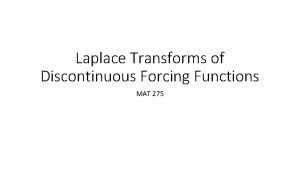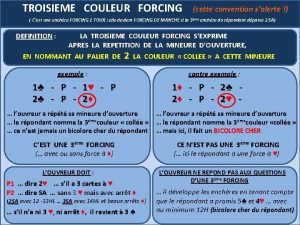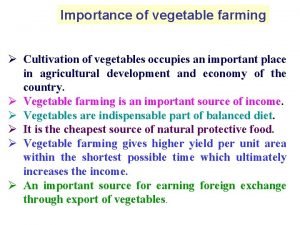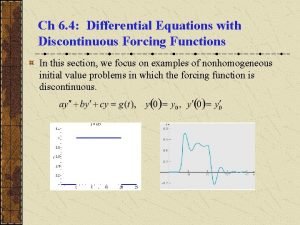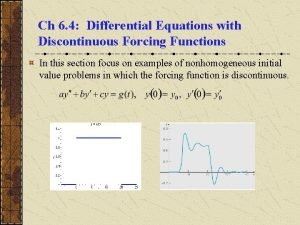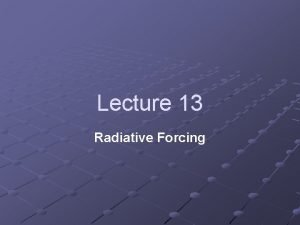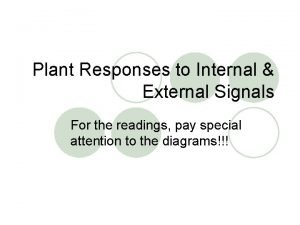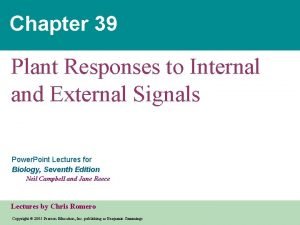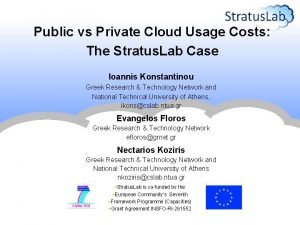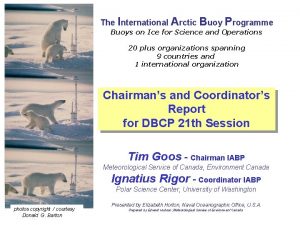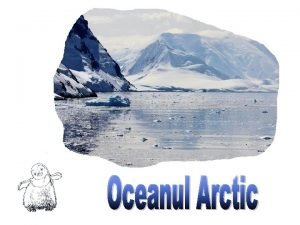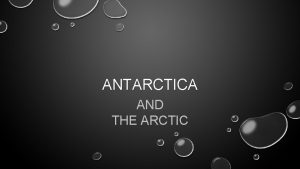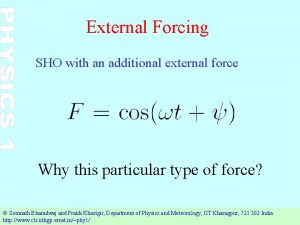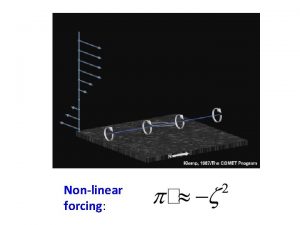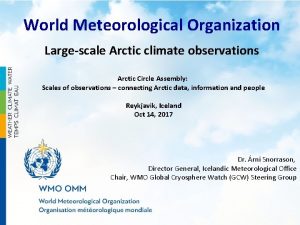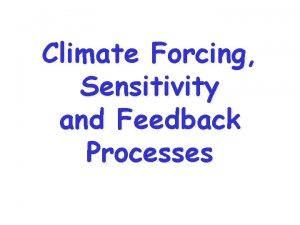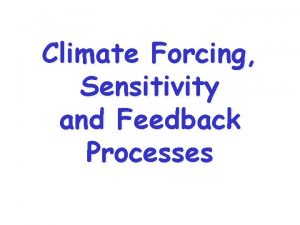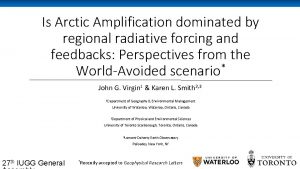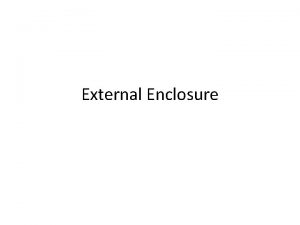Arctic Cloud Responses to External Forcing in Climate
















- Slides: 16

Arctic Cloud Responses to External Forcing in Climate and Weather Models Yuan Wang Jonathan Jiang, Hui Su, Chuanfeng Zhao, Jiwen Fan, Yi Ming, Yuk Yung JPL, California Institute of Technology; Beijing Normal University; PNNL/DOE; GFDL/NOAA, Princeton

Arctic Sea Ice and Cloud Satellite era National Snow and Ice Data Center (NSIDC) Version 1. 1 • Arctic clouds effectively regulate the radiation balance and are closely linked with sea ice variations. • The responses of Arctic clouds to external forcings are highly uncertain. • Arctic sea ice cover has been shrinking at an unprecedented rate since the 1970 s. • GHG and natural variability have contributed, but aerosol effect is muted due to the emission shift [Wang et al. 2017].

Arctic Cloud Simulations In NCAR CESM Surf. Cloud Forcing in CESM Arctic Cloud Fraction ARM measurements at Barrow, AL [Zhao, 2015]

Arctic Cloud Simulations In CESM/CMIP 5 DFJ Liquid MAM JJA SON 20 10 0 CESM % -10 Ice -20 [Kay, 2016] CMIP 5 Models [Wang, in Prep. ]

Model Setup and Experiments Design NCAR/DOE CESM 1. 0. 4 Sea Ice CICE 4 Atmo. CAM 5 Coupler Land CLM 4 • • CAM 5 => Atmospheric only response CESM => fully coupled response Ensemble simulations Compare the equilibrium states under different forcing scenarios. Ocean POP 2 ü ü Aerosol Radiative Effect CCN Effect (stratiform clouds) IN Effect (mixed phase clouds) Aerosol Albedo Effect (deposited on ice/snow) [Creamean et al. ]

Possible GHG and Aerosols Changes in Future Forcing Scenarios following RCP 6. 0: o ΔGHG 2050 -2010 o ΔAnthropogenic Aerosol 2050 -2010 Projected AOD Changes Projected CO 2 Emission

Cloud Responses in Atmosphere-Only Model Qc Qice Qv (mg/kg) (g/kg) Qc Qice CCN (mg/kg) ΔGHG 2050 -2010 ΔAerosol 2050 -2010 (#/cm 3) SS 0. 1%

Cloud Forcing in Coupled System • GHG Liquid Cloud Surf. Radiation • In JJA, cloud feedback can override clearsky lapse rate and water vapor feedbacks. • Aerosol Liquid Cloud Albedo & Amount Surf. Radiation • Positive cloud forcing contributes to 28% of surface radiation enhancement. ΔCloud ΔClearsky

Future GHG and Aerosols Impacts on Sea Ice GHG Forcing (2050− 2010) Aerosol Forcing (2050− 2010) Mean = - 7. 1% Mean = - 24. 0% Sept. Sea Ice Loss (%)

Aerosol Effect : Inside or Outside of Arctic? ΔAerosol 2050 -2010 All Latitudes: Fixed Arctic:

Simulated Aerosol Effects Outside of Arctic Stability Mid-lat. Aerosol Mid-lat. Warming V 850 h. Pa. T 850 h. Pa Arctic Low-level Stability Low Clouds. [Wang et al. , 2017, J. Clim. ]

Simulating Aerosol Microphysical Effects on Cloud Scale • DOE/ARM NSA surface measurement + ARM ISDAC field campaign • Two-day simulations of CCN/IN effects using WRF with a spectra-bin microphysics (33 bins for each hydrometeors). • CCN/IN treatment: • Prognostic CCN and IN • De. Mott [2015] heterogeneous Ice nucleation. • Regeneration of CCN/IN is on • Real-case model setup: • IC/BC – ERA-Interim • horizontal – 500 m • Vertical – 65 levels (40 m in PBL)

Aircraft Measured CCN/IN Variations During ISDAC CCN (cm-3) Flight Apr. 26 IN Concen. (L-1) CCN (cm-3) Flight Apr. 18 [Mc. Farquhar, 2011]

WRF Simulated CCN and IN Effects CCN 2000 cm-3 32 cm-3 10 L-1 1 L-1 IN

Conclusion • Cloud responses to GHG and aerosol forcing are distinctive in the Arctic. • Aerosol reduction inside of the Arctic can cause a decrease in cloudiness, a significant surface warming, and sea ice melt subsequently. • Process-level cloud-resolving simulations confirm efficient aerosol indirect effect on mixed phase clouds. Large cloud sensitivity to IN.

Thank you! • Wang, Y. , et al. , “Elucidating the Influence of Anthropogenic Aerosols On the Arctic Sea Ice”, J. Climate, doi: 10. 1175/JCLI-D-17 -0287. 1 (2017) • Wang, Y. , et al. , “Process-level understanding of cloud responses to greenhouse gas and aerosol perturbations” (In prep. )
 Discontinuous forcing functions
Discontinuous forcing functions Salerte
Salerte Closed center curls
Closed center curls Importance of vegetable farming
Importance of vegetable farming Differential equations with discontinuous forcing functions
Differential equations with discontinuous forcing functions Differential equations with discontinuous forcing functions
Differential equations with discontinuous forcing functions Radiative forcing definition
Radiative forcing definition Plant responses to internal and external signals
Plant responses to internal and external signals Chapter 39 plant responses to internal and external signals
Chapter 39 plant responses to internal and external signals Climate change 2014 mitigation of climate change
Climate change 2014 mitigation of climate change External-external trips
External-external trips Snapcloud
Snapcloud The cloud in cloud computing refers to
The cloud in cloud computing refers to Cloud to cloud integration patterns
Cloud to cloud integration patterns Public cloud vs private cloud cost analysis
Public cloud vs private cloud cost analysis Jamstec
Jamstec Oceanul arctic animale
Oceanul arctic animale
